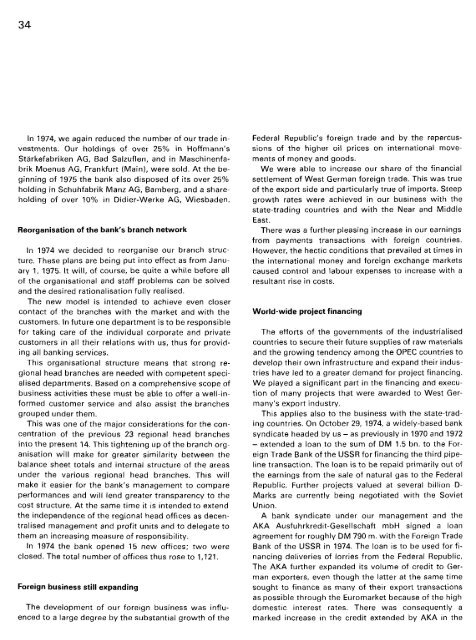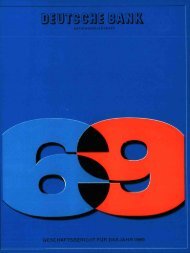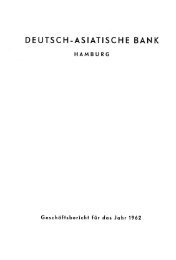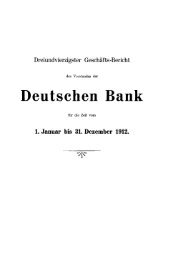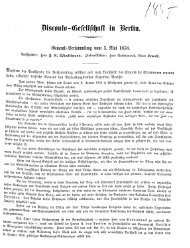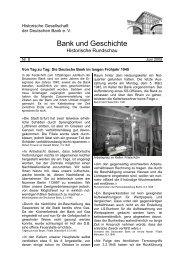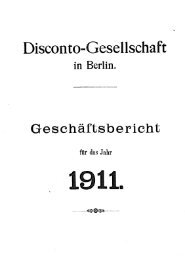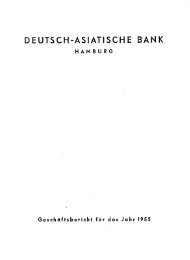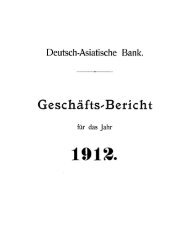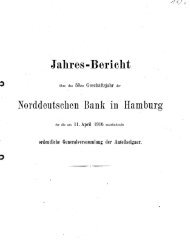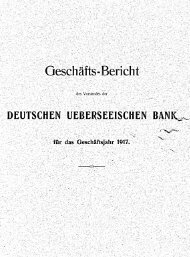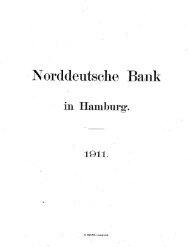Deutsche Bank 1 - Historische Gesellschaft der Deutschen Bank e.V.
Deutsche Bank 1 - Historische Gesellschaft der Deutschen Bank e.V.
Deutsche Bank 1 - Historische Gesellschaft der Deutschen Bank e.V.
Create successful ePaper yourself
Turn your PDF publications into a flip-book with our unique Google optimized e-Paper software.
In 1974, we again reduced the number of our trade in-<br />
vestments. Our holdings of over 25% in Hoffmann's<br />
Stärkefabriken AG, Bad Salzuflen, and in Maschinenfa-<br />
brik Moenus AG, Frankfurt (Main), were cold. At the be-<br />
ginning of 1975 the bank also disposed of its over 25%<br />
holding in Schuhfabrik Manz AG, Bamberg, and a share-<br />
holding of over 10% in Didier-Werke AG, Wiesbaden.<br />
Reorganisation of the bank's branch network<br />
In 1974 we decided to reorganise our branch struc-<br />
ture. These plans are being put into effect as from Janu-<br />
ary 1, 1975. It will, of Course, be quite a while before all<br />
of the organisational and staff Problems can be solved<br />
and the desired rationalisation fully realised.<br />
The new model is intended to achieve even closer<br />
contact of the branches with the market and with the<br />
customers. In future one department is to be responsible<br />
for taking care of the individual corporate and private<br />
customers in all their relations with us, thus for provid-<br />
ing all banking services.<br />
This organisational structure means that strong re-<br />
gional head branches are needed with competent speci-<br />
alised departments. Based on a comprehensive scope of<br />
business activities these must be able to offer a well-in-<br />
formed customer service and also assist the branches<br />
grouped un<strong>der</strong> them.<br />
This was one of the major consi<strong>der</strong>ations for the con-<br />
centration of the previous 23 regional head branches<br />
into the present 14. This tightening up of the branch org-<br />
anisation will make for greater similarity between the<br />
balance sheet totals and internal structure of the areas<br />
un<strong>der</strong> the various regional head branches. This will<br />
make it easier for the bank's management to compare<br />
performances and will lend greater transparency to the<br />
cost structure. At the same time it is intended to extend<br />
the independence of the regional head offices as decen-<br />
tralised management and profit units and to delegate to<br />
them an increasing measure of responsibility.<br />
In 1974 the bank opened 15 new offices; two were<br />
closed. The total number of offices thus rose to 1,121.<br />
Foreign business still expanding<br />
The development of our foreign business was influ-<br />
enced to a large degree by thc substantial growth of the<br />
Fe<strong>der</strong>al Republic's foreign trade and by the repercus-<br />
sions of the higher oil prices on international rnove-<br />
ments of money and goods.<br />
We were able to increase our share of the financial<br />
Settlement of West German foreign trade. This was true<br />
of the export side and particularly true of imports. Steep<br />
growth rates were achieved in our business with the<br />
state-trading countries and with the Near and Middle<br />
East.<br />
There was a further pleasing increase in our earnings<br />
from payments transactions with foreign countries.<br />
However, the hectic conditions that prevailed at times in<br />
the international money and foreign exchange markets<br />
caused control and labour expenses to increase with a<br />
resultant rise in costs.<br />
World-wide project financing<br />
The efforts of the governments of the industrialised<br />
countries to secure their future supplies of raw materials<br />
and the growing tendency among the OPEC countries to<br />
develop their own infrastructure and expand their indus-<br />
tries have led to a greater demand for project financing.<br />
We played a significant Part in the financing and execu-<br />
tion of many projects that were awarded to West Ger-<br />
many's export industry.<br />
This applies also to the business with the state-trad-<br />
ing countries. On October 29, 1974, a widely-based bank<br />
syndicate headed by us - as previously in 1970 and 1972<br />
- extended a loan to the sum of DM 1.5 bn. to the For-<br />
eign Trade <strong>Bank</strong> of the USSR for financing the third pipe-<br />
line transaction. The loan is to be repaid primarily out of<br />
the earnings from the sale of natural gas to the Fe<strong>der</strong>al<br />
Republic. Further projects valued at several billion D-<br />
Marks are currently being negotiated with the Soviet<br />
Union.<br />
A bank syndicate un<strong>der</strong> our management and the<br />
AKA Ausfuhrkredit-<strong>Gesellschaft</strong> mbH signed a loan<br />
agreement for roughly DM 790 m. with the Foreign Trade<br />
<strong>Bank</strong> of the USSR in 1974. The loan is to be used for fi-<br />
nancing deliveries of lorries from the Fe<strong>der</strong>al Republic.<br />
The AKA further expanded its volume of credit to Ger-<br />
man exporters, even though the latter at the same time<br />
sought to finance as many of their export transactions<br />
as possible through the Euromarket because of the high<br />
domestic interest rates. There was consequently a<br />
marked increase in the credit extended by AKA in the


